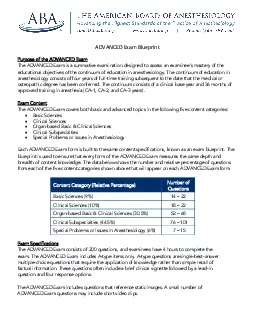

Purpose of the ADVANCED ExamThe ADVANCED Exam is a summative examination designed to assess an examinees mastery of the educational objectives of the continuum of education in anesthesiology The conti ID: 886155
Download Pdf The PPT/PDF document "ADVANCED Exam Blueprint" is the property of its rightful owner. Permission is granted to download and print the materials on this web site for personal, non-commercial use only, and to display it on your personal computer provided you do not modify the materials and that you retain all copyright notices contained in the materials. By downloading content from our website, you accept the terms of this agreement.
1 ADVANCED Exam Blueprint Purpose of t
ADVANCED Exam Blueprint Purpose of the ADVANCED Exam The ADVANCED Exam is a summative examination designed to assess an examinee’s mastery of the educational objectives of the continuum of education in anesthesiology. The continuum of education in anesthesiology consists of four years of full - time training subsequent to the date that the medical or osteopathic degree has been conferred. The continuum consists of a clinical base year and 36 months of approved training in ane sthesia (CA - 1, CA - 2 , and CA - 3 years). Exam Content The ADVANCED Exam covers both basic and advanced topics in the following five content categories: • Basic Sciences • Clinical Sciences • Organ - based Basic & Clinical Sciences • Clinical Subspecialties • Special Problems or Issues in Anesthesiology Each ADVANCED Exam form is built to the same content specifications, known as an exam blueprint. The blueprint is used to ensure that every form of the ADVANCED Exam measures the same depth and b readth of content knowledge. The data below shows the number and relative percentage of questions from each of the five content categories shown above that will appear on each ADVANCED Exam form. Content Category (Relative Percentage) Number of Questions Basic Sciences (9%) 1 4 – 2 2 Clinical Sciences (10% ) 18 – 2 2 Organ - b ased Basic & Clinical Sciences (30 .5 % ) 52 – 68 Clinical Subspecialties (4 4.5 %) 76 – 101 Special Problems or Issues in Anesthesiology ( 6 %) 7 – 1 5 Exam Specifications The ADVANCED Exam consists of 200 questions , and examinees have 4 hours to complete the exam. The ADVANCED Exam includes A - type items only. A - type questions are single - best - answer multiple - choice questions that require the application of knowledge rather than simple recall of factual information. These questions often include a brief clinical vignette followed by a lead - in question and four response options. The ADVANCED Exam in
2 cludes questions that reference static i
cludes questions that reference static images. A small number of ADVANCED Exam ques tions may include short video clips. Exam Administration The ADVANCED Exam is administered twice each year to physicians that have successfully completed an ACGME - accredited anesthesiology residency training program. The ADVANCED Exam is a computer - based exam that is administered through Pearson VUE centers nationwide. Content Category (Relative Percentage) Number of Questions BASIC SCIENCES (9%) 1 4 – 2 2 Anatomy 3 – 5 Physics, Monitoring & Anesthesia Delivery Devices 4 – 6 Mathematics 3 – 5 Pharmacology 4 – 6 CLINICAL SCIENCES (10% ) 18 – 2 2 Regional Anesthesia 11 – 13 Special Techniques 7 – 9 ORGAN - BASED BASIC & CLINICAL SCIENCES (30 .5 % ) 52 – 68 Central & Peripheral Nervous System 9 – 11 Respiratory System 9 – 11 Cardiovascular System 9 – 11 Gastrointestinal/Hepatic Systems 4 – 6 Renal & Urinary Systems/Electrolyte Balance 6 – 8 Hematologic System 7 – 9 Endocrine & Metabolic Systems 4 – 6 Neuromuscular Diseases & Disorders 4 – 6 CLINICAL SUBSPECIALTIES (4 4.5 % ) 76 – 101 Painful Disease States 15 – 1 7 Pediatric Anesthesia 15 – 1 7 Obstetric Anesthesia 15 – 1 7 Otorhinolaryngology (ENT) Anesthesia 3 – 5 Anesthesia for Plastic Surgery, Liposuction 1 – 3 Anesthesia for Laparoscopic Surgery 2 – 4 Ophthalmologic Anesthesia 1 – 3 Orthopedic Anesthesia 1 – 3 Trauma, Burn Management, Mass Casualty, Biological Warfare 2 – 4 Anesthesia for Ambulatory Surgery 2 – 4 Geriatric Anesthesia/Aging 3 – 5 Critical Care 1 7 – 19 SPECIAL PROBLEMS OR ISSUES IN ANESTHESIOLOGY ( 6 % ) 7 – 1 5 Electroconvulsive Therapy 0 – 2 Organ Donors 2 – 4 Radiologic Procedures 2 – 4 Ethics, Practice Management & Medicolegal Issues 3 – 5